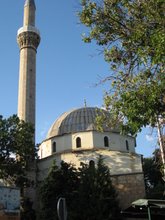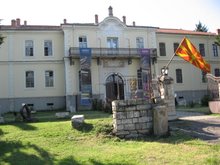Saat Kula clock tower. It is not known when the clock tower was built. Written sources from the 16th century mention a clock tower, but it is not clear if it is the same one. Some believe it was built at the same time as St. Dimitrija Church, in 1830. Legend says that the Ottoman authorities collected around 60 000 eggs from nearby villages and mixed them in the mortar to make the walls stronger.The tower has a rectangular base and is about 30 meters high. Near the top is a rectangular terrace with an iron fence. On each side of the fence is an iron console construction which holds the lamps for lighting the clock. The clock is on the highest of three levels. The original clock was replaced during World War II with a working one, given by the Nazis because the city had maintained German graves from World War I.The massive tower is composed of walls, massive spiral stairs, wooden mezzanine constructions, pendentives (triangular pass from square to cupola) and cupola. During the construction of the tower, the facade was simultaneously decorated with simple stone plastic.
St. Dimitrija Church was built in 1830 with voluntary contributions of local merchants and craftsmen. It is plain on the outside, as all churches in the Ottoman Empie had to be, but of rare beauty inside, lavishly decorated with chandeliers, a carved bishop throne and an engraved iconostasis. According to some theories, the iconostasis is a work of the Miyak engravers. Its most impressive feature is the arc above the imperial quarters with modeled figures of Jesus and the apostles.Other engraved wood items include the bishop’s throne made in the spirit of Miyak engravers, several icon frames and five more-recent pillars shaped like thrones. The frescos originate from two periods: the end of the 19th century, and the end of World War I to the present. The icons and frescos were created thanks to voluntary contributions of local businessmen and citizens. The authors of many of the icons had a vast knowledge of iconography schemes of the New Testament. The icons show a great sense of color, dominated by red, green and ochra shades. The abundance of golden ornaments is noticeable and points to the presence of late - Byzantine artwork and baroque style. The icon of St. Dimitrij is signed with the initials "D. A. Z.", showing that it was made by iconographer Dimitar Andonov the zograph in 1889. There are many other items, including the putiri made by local masters, a darohranilka of Russian origin, and several paintings of scenes from the New Testament, brought from Jerusalem by pilgrims.
Ajdar-kadi (Turkish judge) mosque is one of the most attractive monuments of the Islamic architecture in Bitola. It was built in 1561-1562, as the project of the famous architect Mimar Sinan, ordered by the Bitola kadija Ajdar-kadi. Over time, it was abandoned and heavily damaged, but recent restoration and conservation has restored to some extent its original appearance.
Jeni mosque is located in the center of the city. It has a square base, topped with a cupola. Near the mosque is a minaret, 40 m high. Today, the mosque's rooms house permanent and temporary art exhibitions. Recent archaeological excavations have revealed that it has been built upon an old church.Ishak mosque is the inheritance of the famous kadi Ishak Celabi. In its spacious yard are several tombs, attractive because of the soft, molded shapes of the sarcophagi.
The bazaar (old market) is mentioned in a description of the city from the 16th and the 17th century. The present bezisten does not differ much in appearance from the original one. The bezisten had 86 shops and 4 large iron gates. The shops used to sell textiles, and today sell food products.
Bath Deboj is a Turkish bath (hamam). When it was constructed is not known. It was heavily destroyed, but after repairs it regained its original appearance: beautiful facade, two large cupolas and several minor ones.
Subscribe to:
Post Comments (Atom)













1 comment:
Eh Marija Marija imas smisol za fotosi, epten...
Duri sega na raat( mir) ti go gledam blogot i fantasticen e.
Puno pozdrav od vreliot Stip.
Sanja
Post a Comment